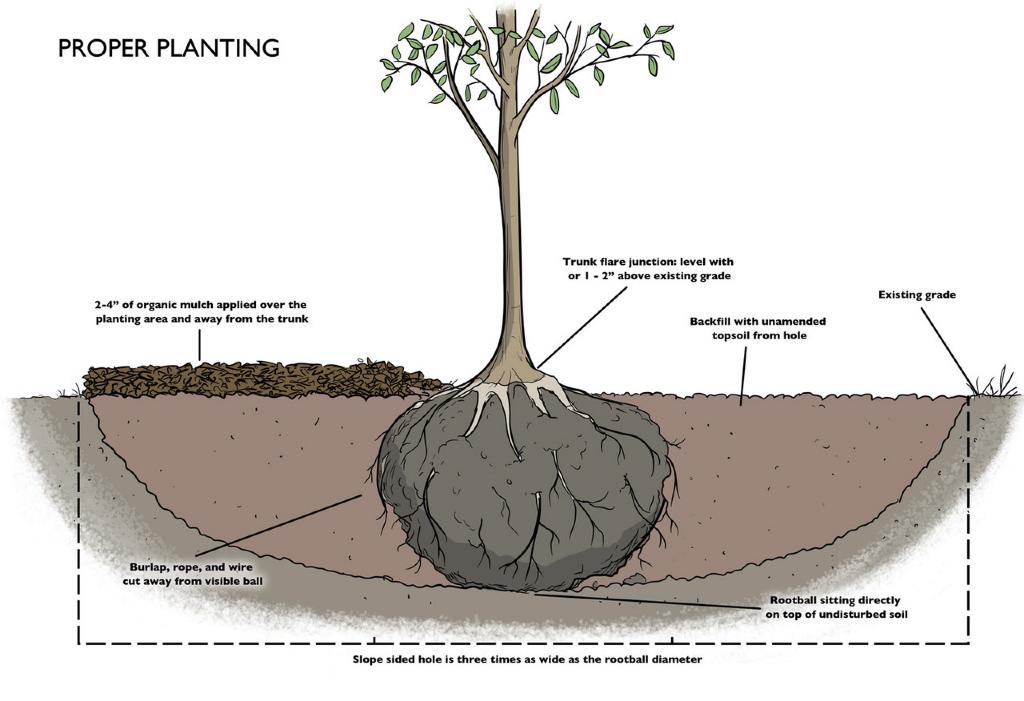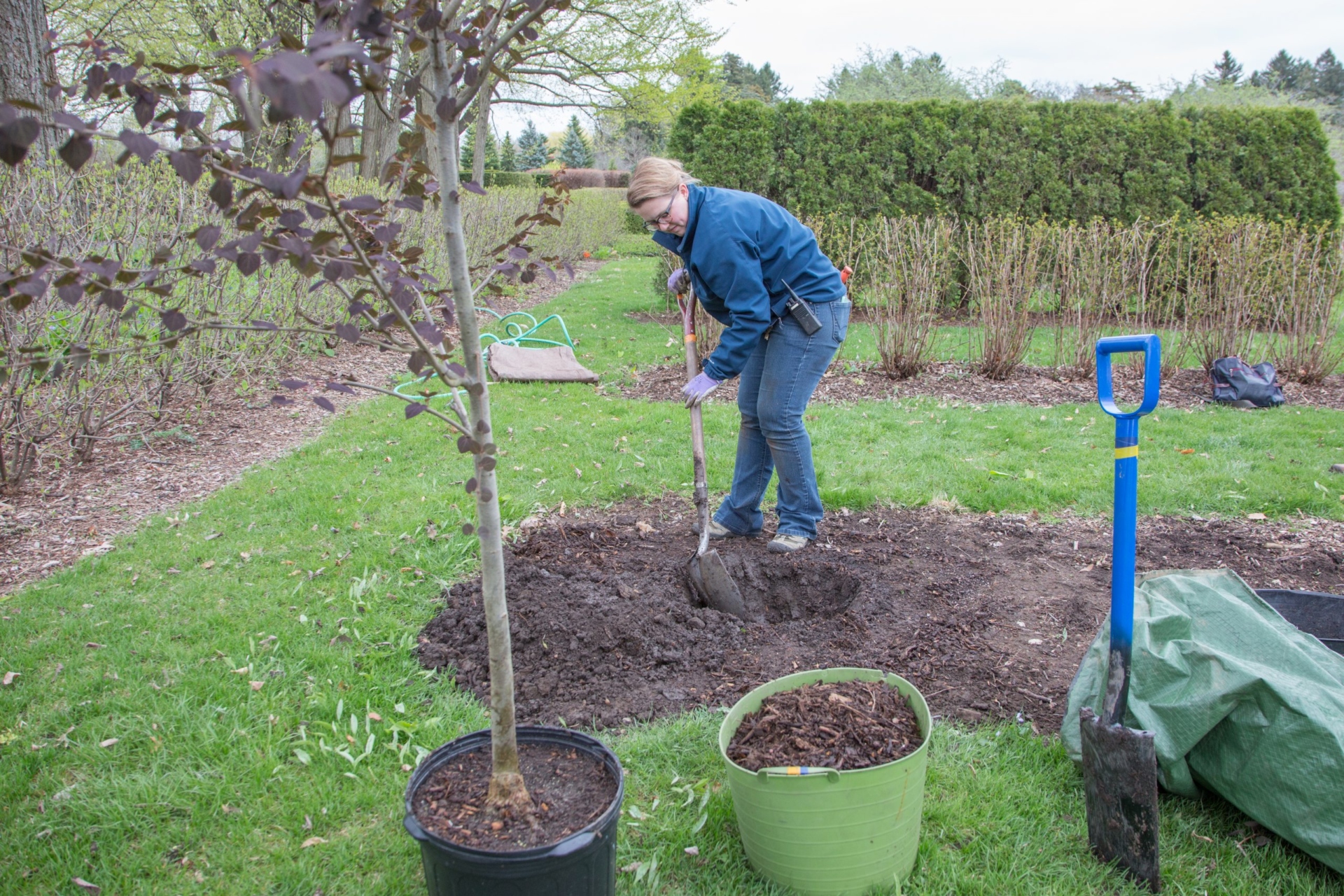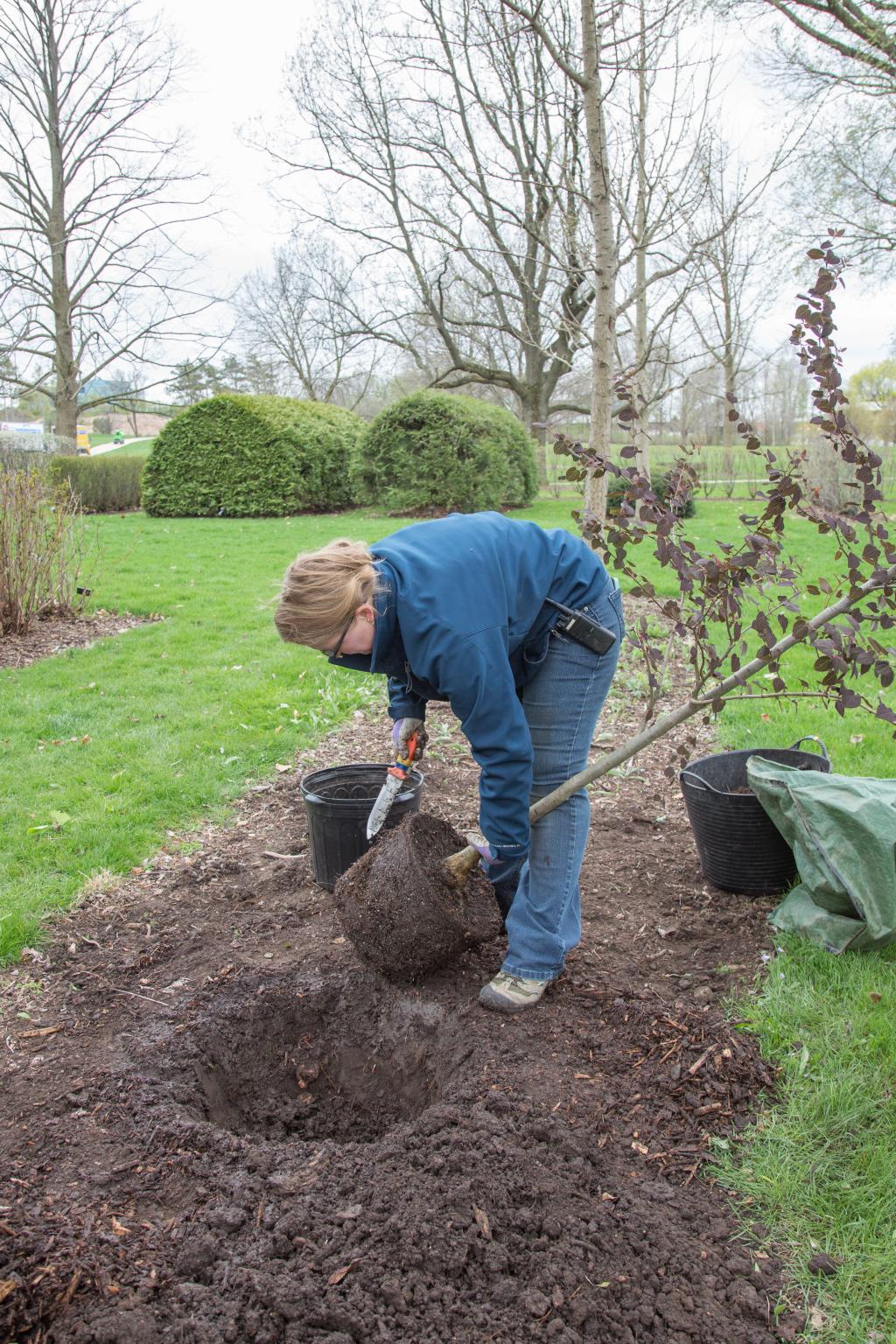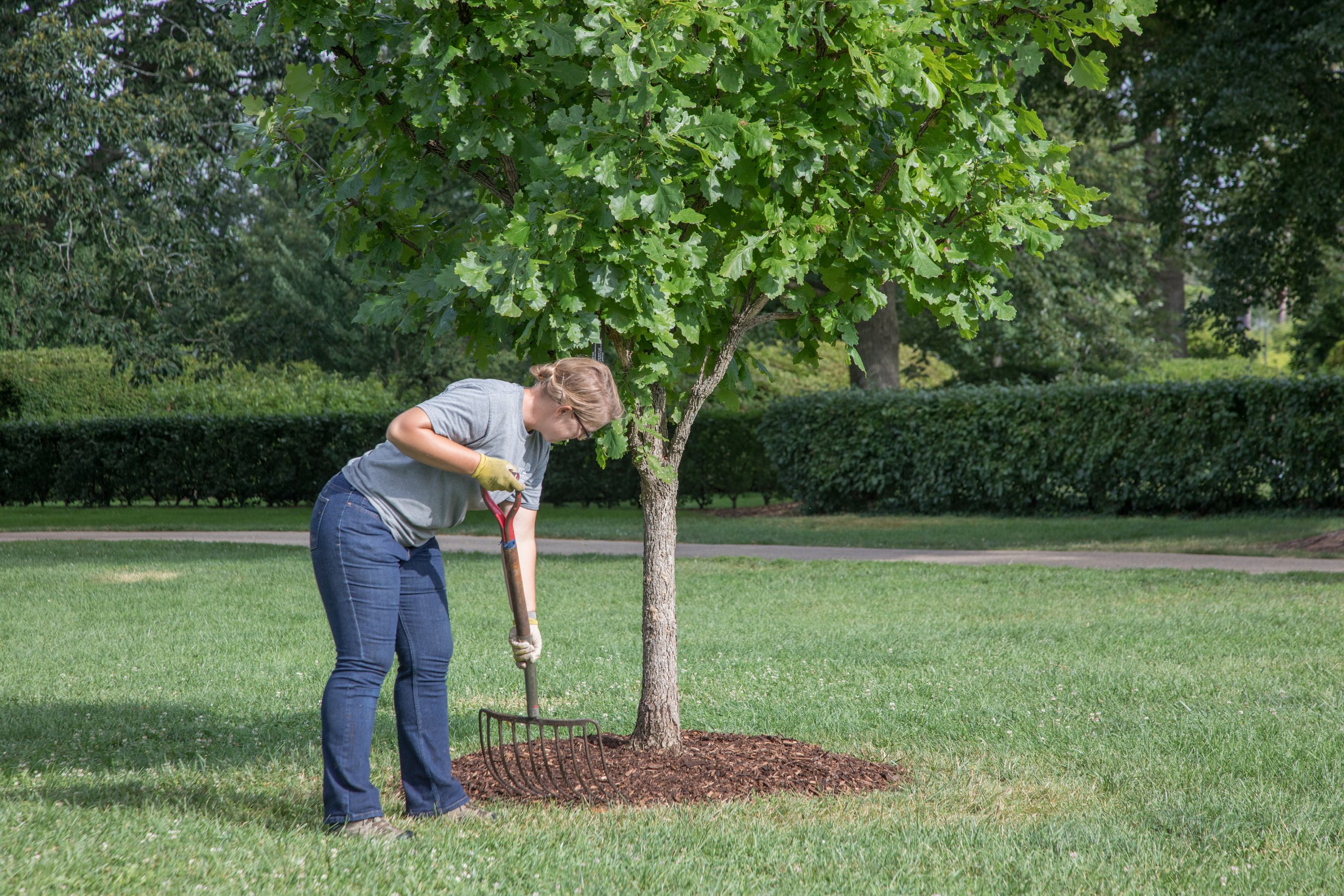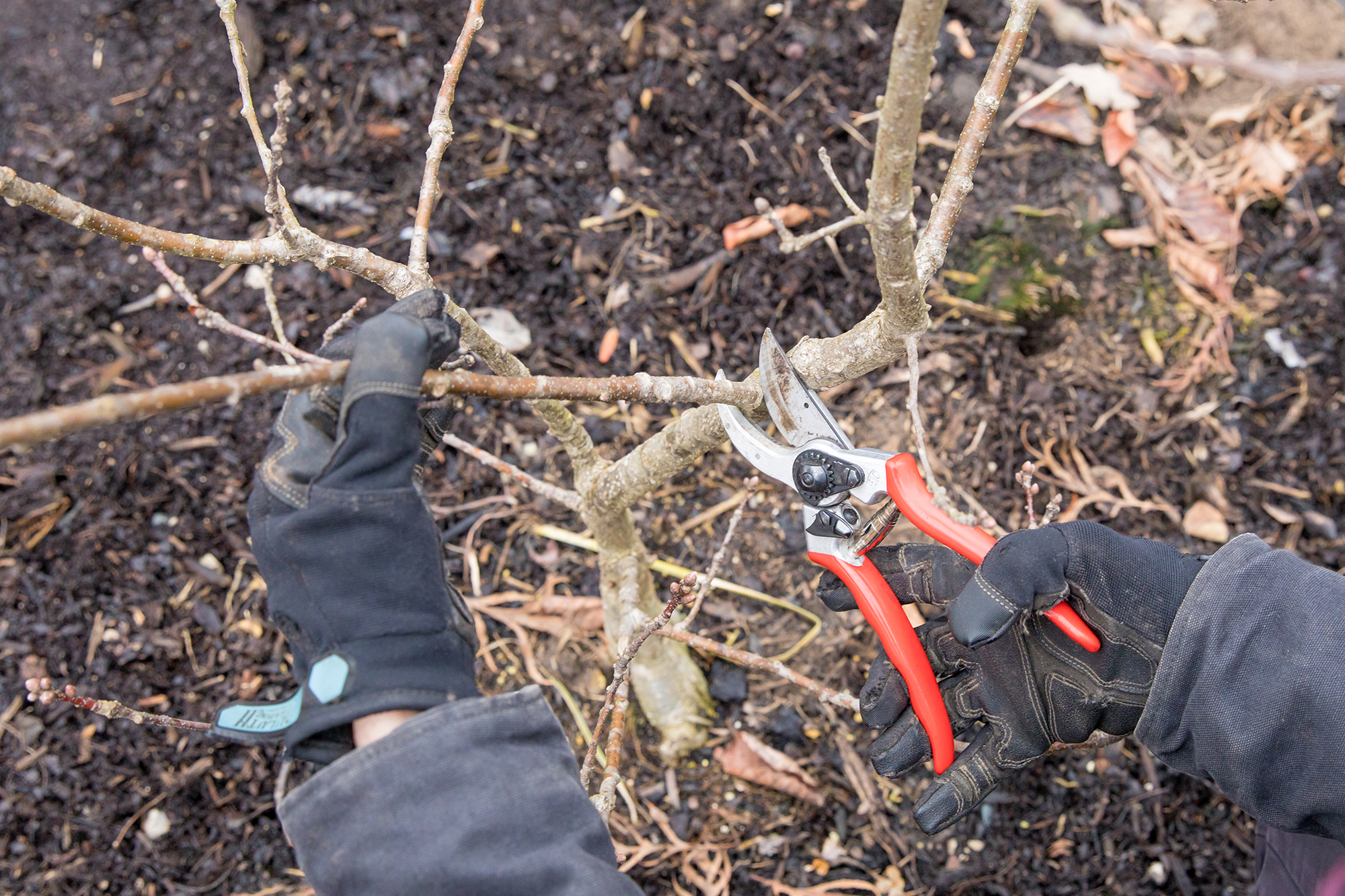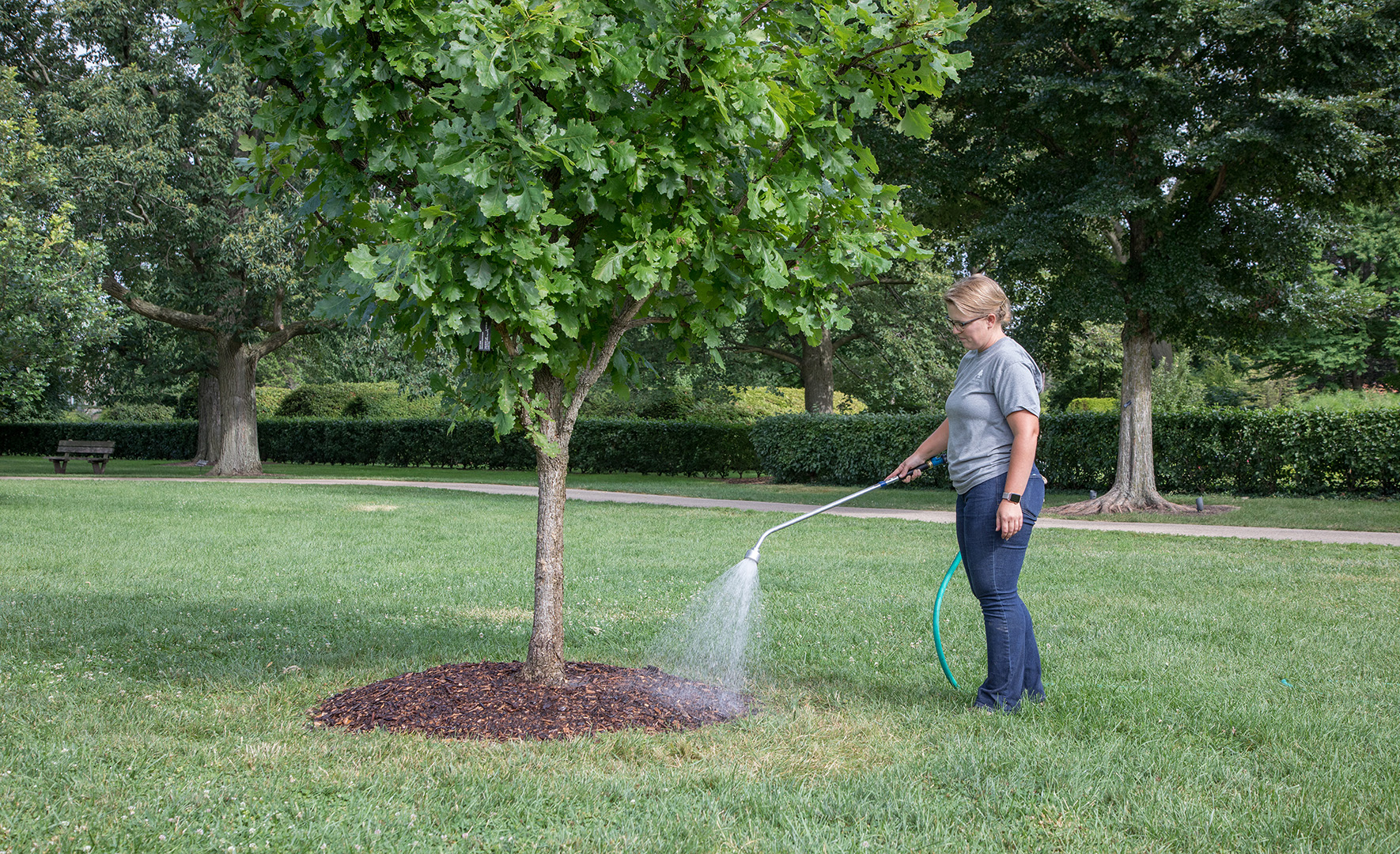Trees can be obtained from the nursery in many forms—bare root, container-grown, balled and burlapped, or dug by tree spade. Transplanting can be successful with all forms. Always put extra effort into the planting process to ensure a good start for your tree. The faster the root system is re-established, the better the chances for survival, and the more rapidly it will grow.
The Planting Site
Planting too deep is one of the most commonly encountered problems of landscape trees. It is not uncommon for trees to come from the nursery with the roots already too deep in the root ball. If the existing soil from the planting hole has a high clay content and is not friable (crumbly), it could be amended with up to 10-15 percent composted organic matter (leave mold or compost) before backfilling the hole.
Drainage
In poorly drained, compacted soils, typical of modern housing developments, improved drainage may be needed. The planting hole can hold water like a bucket. More urban trees die from too much water than from not enough water. To test the drainage of your planting hole, pour a few gallons of water in the hole before planting the tree. If it hasn’t soaked in after an hour, you have a drainage problem. If the hole is near a slope, you may be able to run a small, underground drain pipe from the bottom of the planting hole to lower down on the slope.
Planting Procedure
The planting hole should be wider than the roots or root ball, two to three times wider is recommended.
The planting hole should only be as deep as the root ball. Don’t dig the hole any deeper than the depth of the roots or root ball because the tree needs support from underneath to stabilize it. Make sure the root collar, or area of the trunk that flares out near the soil line, is visible. The uppermost lateral roots should be just below the soil surface.
The sides of the hole should slope up gradually, making it saucer- or bowl-shaped.
Container or Bare-Root Plants
Remove plant from container or packaging material and inspect the root system for dead or injured roots. Remove damaged roots and cut back spiraling roots to encourage proper development. Shaving a thin layer of roots from the root ball is the best way to eliminate roots circling along the container wall.
Center the plant in the planting hole. Keep it straight with the branches pointing in the direction you want them to grow.
Backfill the planting hole with soil, gently filling around the roots to eliminate air pockets.
With the extra remaining soil, create a saucer or water basin around the outer edge of the soil ball. This will keep water in the root zone and prevent runoff. The basin should be removed before winter.
Balled-and-Burlapped Plants
Once the plant is in the hole, remove all twine and cut as much burlap as possible. If the plant is in a wire basket, remove as much wire as possible. Low-profile baskets are designed so no wire needs to be removed.
Work the prepared soil firmly around the soil ball, but do not compact.
Fertilization
Fertilization at the time of planting is not recommended. Until a root system is large enough to absorb more water research has shown that fertilization is ineffective until the tree has had time to partially re-establish its root system.
When to Transplant
Spring is the best season for transplanting. The longer growing season allows roots to re-establish before winter. Fall also is considered a good time to plant, but allow 6 weeks before the ground freezes for plants to establish new roots. Some species do not transplant well in the fall (e.g., birch, magnolia, poplar, redbud). Summer planting is possible if a judicious watering program is followed, particularly if the plants were dug from the nursery in spring or grown in containers.
Mulching
Properly applied mulch can increase tree growth in the first few years after planting. Apply an even layer of mulch, 3-4 inches deep, with a diameter at least four times the diameter of the root ball, should be placed around every newly planted tree to conserve soil moisture and help moderate soil temperatures. Do not mound the mulch or let it rest against the trunk of the tree.
Staking
When stability is a problem, such as windy sites or sandy soils, trunks of trees should be staked for 1-3 years until new lateral roots stabilize the tree. Avoid staking too rigidly. Guy wires or staking materials should be checked monthly during the growing season to prevent damage to the bark. Failure to loosen or remove staking wires has girdled many trees.
Trunk Wraps
Young trees and trees with thin bark (e.g. maple) can be damaged by very cold weather. Stems can be protected by wrapping trunks in late fall, from the bottom up so that the wrap overlaps like shingles. There are numerous tree wraps and loose tree collar wraps available commercially. Remove the wrap each spring. Trunk wrapping is not essential on all trees. It is most beneficial on young trees with thin bark.
Pruning
It is very important to ensure the best possible branch structure while trees are young. At the time of planting, remove all rubbing branches, dead, or broken branches. Side branches of trees with a central leader should be evenly spaced up and down the trunk. Do not allow more than one leader in shade trees or conifers.
Watering
Proper watering is the single most important aspect of maintaining transplanted trees. Too much or too little water can cause damage. In the first few months after planting a tree, most of its moisture comes from the root ball. The root ball can dry out in only a day or two, even if the surrounding soil remains moist.
The only way to know is to probe the soil in the root ball and check its moisture. Even after trees are well established, they should be watered generously during periods of low rainfall (e.g. every 7 to 10 days). Tree water bags have permeable bottoms, which allow the water to drip into the soil of the rootball, where it is needed most. They have the advantage of delivering a specific amount of water. They need to be filled regularly (every 5 to 7 days on average) to be effective. Remove at the end of the season when not needed.
Transplant Stress
Research has shown that a tree can lose 80 to 95% of its root system as a result of transplanting. This causes a great deal of stress. After transplanting, the tree may form fewer and smaller leaves and grow very little. How long the stress period lasts depends on the size of the tree, its site, and the care it is given.
A small tree (2-3 inch diameter), planted on a good site and given adequate water, should return to vigorous growth in 2-3 years. A poor site or inadequate care will lengthen this period. Large trees take longer to recover from transplanting than small trees; approximately 1 year of recovery is needed for each inch of diameter. As long as branches are not dying and growth improves each year, the tree is doing well.
